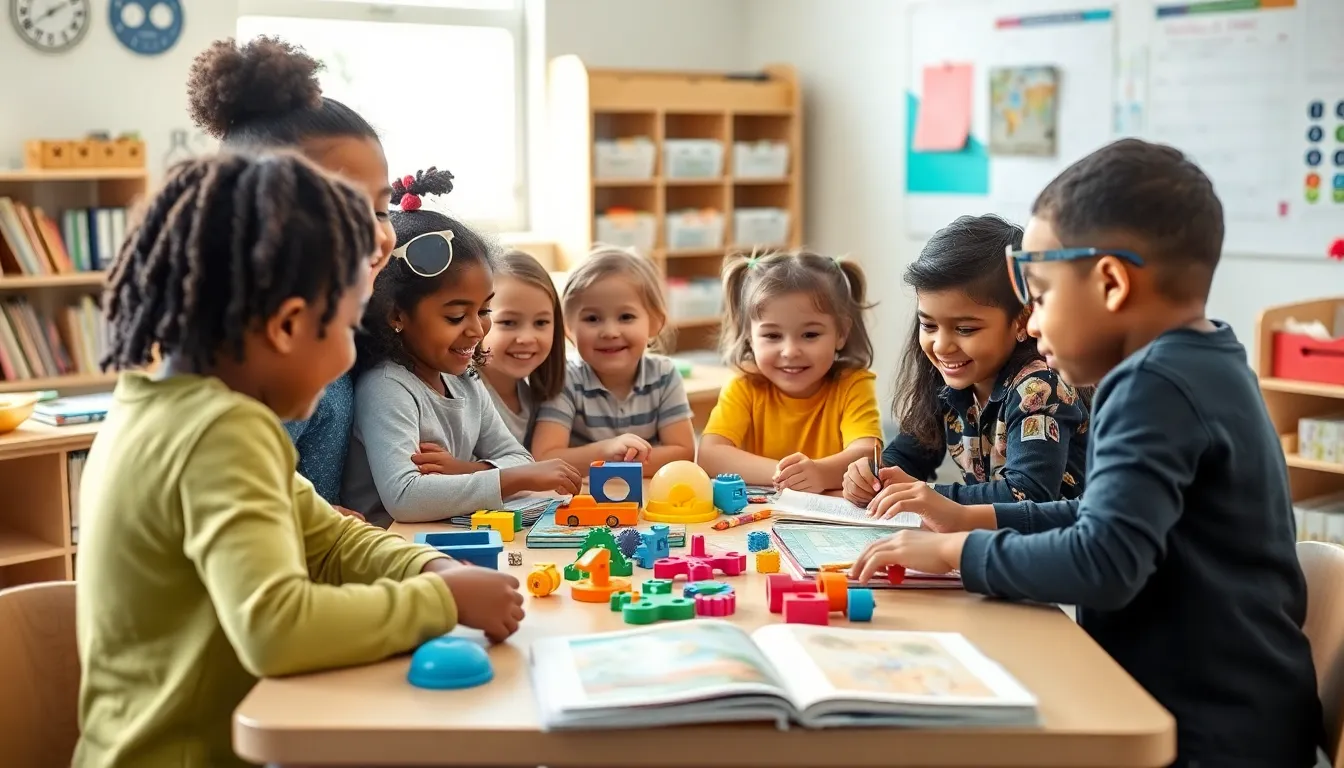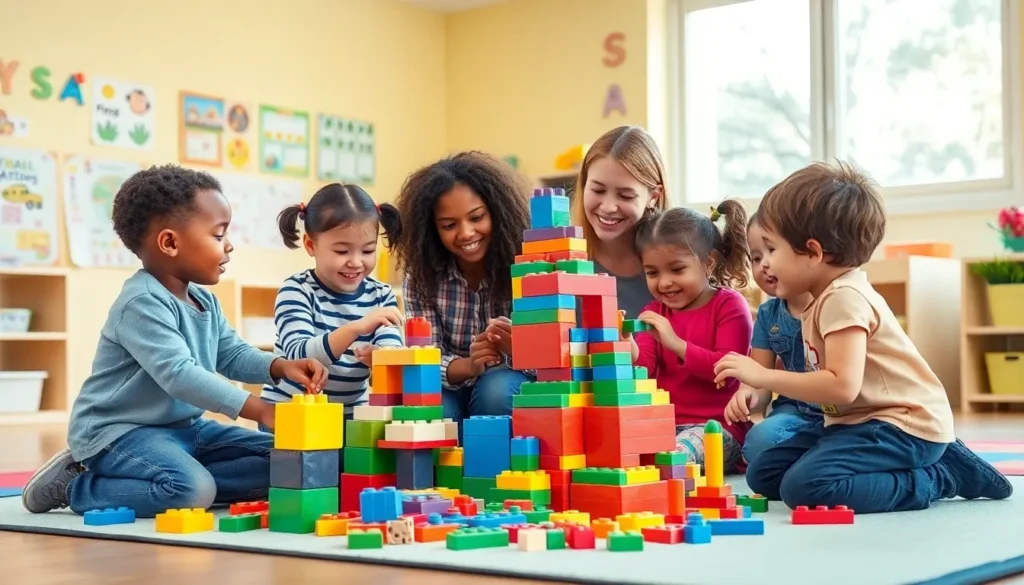Table of Contents
ToggleIn the grand construction site of life, scaffolding isn’t just for builders; it’s essential for nurturing young minds too. Imagine a toddler trying to build a skyscraper out of blocks without any support—chaos, right? That’s where the concept of scaffolding in child development comes in, providing the necessary framework for kids to reach new heights.
Understanding Scaffolding Child Development
Scaffolding in child development refers to the support provided to children as they learn new skills. This process equips children with the tools necessary for independent problem-solving.
Definition of Scaffolding
Scaffolding represents temporary assistance tailored to a child’s current abilities. This support facilitates learning by breaking down tasks into manageable steps. As children engage with new concepts, caregivers or educators guide them through challenges. Effective scaffolding adjusts based on the child’s progress, ensuring that support decreases as the child gains confidence and competence.
Importance in Child Development
Scaffolding plays a crucial role in promoting cognitive and emotional growth. It nurtures a child’s curiosity while fostering resilience in the face of challenges. Through effective scaffolding, children develop important skills such as critical thinking, communication, and collaboration. This approach encourages children to take risks during the learning process. Research indicates that well-structured support leads to better educational outcomes, enhancing a child’s overall development.
Theoretical Frameworks

Theoretical frameworks provide essential insights into scaffolding child development. They explain how support structures facilitate learning and skill acquisition.
Vygotsky’s Zone of Proximal Development
Vygotsky’s Zone of Proximal Development (ZPD) emphasizes the gap between what a child can do independently and what they can achieve with guidance. Often, this framework illustrates how adults or peers contribute by providing appropriate support. Children thrive within their ZPD, where targeted assistance fosters growth and independence. Feedback within this zone encourages exploration and skill refinement, promoting cognitive development. Effective scaffolding aligns with ZPD principles, ensuring that support matches the child’s current capabilities.
Key Theorists and Their Contributions
Key theorists have shaped the understanding of scaffolding in child development. Piaget focused on stages of cognitive development, laying the groundwork for recognizing individual learning processes. Bruner introduced the concept of scaffolding as a way to support learning through guided interactions. Bandura’s social learning theory highlighted the importance of observational learning in skill acquisition. Each theorist’s contributions illustrate the diverse approaches that inform effective scaffolding practices. Understanding their work benefits educators and caregivers in nurturing children’s learning journeys.
Practical Applications
Scaffolding plays a vital role in enhancing child development through various practical applications. Techniques tailored to a child’s needs make learning engaging and achievable.
Techniques for Effective Scaffolding
Begin with breaking down complex tasks into smaller, manageable steps. Use visual aids to illustrate concepts and clarify understanding. Encourage dialogue, allowing children to verbalize their thoughts and solutions. Provide prompts to guide thinking without giving away answers. Adjust support based on the child’s progress, reducing guidance as they gain confidence. Celebrate successes to foster motivation and resilience. Integrate collaborative activities, promoting teamwork and shared learning experiences.
Role of Parents and Educators
Parents and educators serve as essential facilitators in the scaffolding process. They create supportive environments conducive to exploration. By recognizing each child’s unique abilities, caregivers can tailor their approach to meet individual needs. Continuous observation enables them to identify when to introduce new challenges. Effective communication enhances the connection and builds trust, which encourages children to express uncertainties and seek help. Collaboration between home and school ensures consistent support, reinforcing learning across different settings.
Challenges and Considerations
Scaffolding child development presents various challenges. These obstacles can impact the effectiveness of support provided to children during their learning journey.
Common Barriers to Effective Scaffolding
Insufficient training among caregivers often limits their ability to scaffold properly. Many lack a strong understanding of child development principles, leading to poorly tailored support. Communication barriers frequently hinder collaboration between parents and educators. Misunderstandings can arise when sharing a child’s progress, affecting the consistency of support provided. Time constraints significantly reduce the opportunities for caregivers to engage in meaningful interactions. Attention to individual needs gets overlooked due to busy schedules. Finally, rigid educational structures can restrict creative approaches necessary for effective scaffolding.
Adapting Scaffolding to Individual Needs
Recognizing and responding to each child’s unique strengths and challenges is critical. Assessing a child’s current skill level allows caregivers to provide suitable support. Personalizing assistance ensures that scaffolding targets the specific needs of the child. Flexibility in strategies promotes a more conducive learning environment. Implementing varied techniques, such as hands-on activities or one-on-one guidance, can enhance understanding. Regular feedback helps identify what methods work best, further refining the scaffolding process. Encouraging open communication fosters a collaborative relationship, allowing both caregivers and children to thrive during the learning experience.
Scaffolding is a vital strategy in supporting child development. By providing tailored assistance, caregivers and educators can guide children through their learning journeys. This approach fosters independence and resilience while nurturing essential skills like critical thinking and collaboration.
As children progress, effective scaffolding adjusts to their evolving needs, ensuring they receive the right level of support. Understanding the theoretical frameworks behind scaffolding can enhance its application in real-world settings.
By overcoming common challenges and personalizing assistance, caregivers can create a rich environment that encourages exploration and growth. Ultimately, scaffolding not only enhances educational outcomes but also lays the foundation for lifelong learning.




